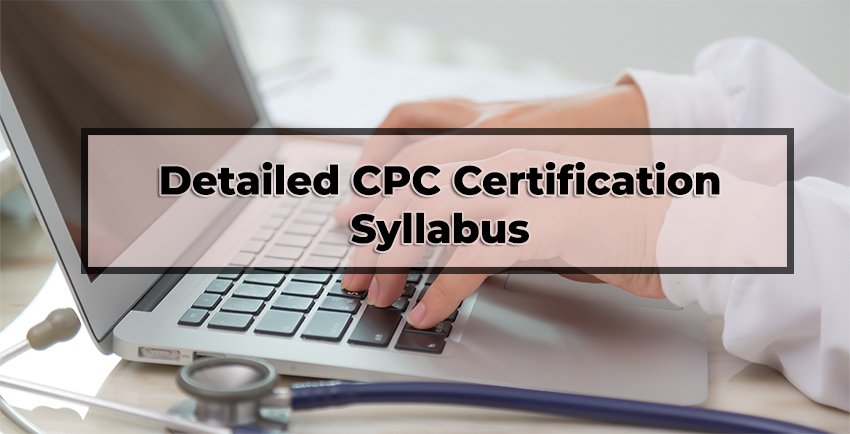Detailed CPC Certification Syllabus
The Certified Professional Coder (CPC) certification, awarded by the American Academy of Professional Coders (AAPC), is one of the most respected credentials in the field of medical coding. Aspiring coders often pursue this certification to demonstrate their proficiency in medical coding and to secure a successful career in healthcare administration. The CPC certification covers an extensive range of topics to ensure coders have a deep understanding of coding procedures, regulations, and healthcare compliance.

This guide provides a detailed breakdown of the CPC certification syllabus to help candidates prepare effectively.
1. Medical Terminology and Anatomy
Medical terminology and anatomy form the foundation for medical coding. Coders must be able to recognize and understand terms related to the human body, diseases, and procedures. This section ensures that coders can identify medical conditions and corresponding codes accurately.
- Medical Terminology: Terms related to diseases, conditions, procedures, and systems.
- Anatomy and Physiology: Covers body systems like cardiovascular, digestive, nervous, respiratory, musculoskeletal, and reproductive systems.
- Root Words, Prefixes, Suffixes: A focus on understanding word parts to make sense of complex medical terms.
- Disease Terminology: Familiarity with common and uncommon diseases.
2. ICD-10-CM Coding Guidelines
The International Classification of Diseases, 10th Revision, Clinical Modification (ICD-10-CM) is an essential coding system used in medical billing. Coders need to master these codes to accurately report diseases, conditions, and health-related problems.
- ICD-10 Structure: Understanding the alphanumeric structure of ICD-10 codes.
- General Coding Guidelines: Proper use of ICD-10-CM codes.
- Chapter-Specific Guidelines: Detailed rules for coding conditions like infectious diseases, neoplasms, and respiratory conditions.
- Reporting Diagnosis Codes: The importance of accurate diagnosis coding in reimbursement.
- Sequencing ICD-10 Codes: How to list primary and secondary diagnosis codes correctly.
3. CPT® (Current Procedural Terminology) Codes
The CPT coding system is essential for documenting medical, surgical, and diagnostic procedures. Coders need to understand the nuances of this system to ensure accurate billing.
- CPT Code Sections: Surgery, radiology, pathology, anesthesia, medicine, and evaluation and management (E/M) coding.
- Modifiers: Using modifiers to provide additional information about the procedure.
- Surgical Package Coding: Understanding the global surgical package.
- Coding Procedures and Services: From minor office visits to complex surgeries.
- Guidelines for E/M Coding: Proper coding for office visits and consultations.
4. HCPCS Level II Codes
Healthcare Common Procedure Coding System (HCPCS) codes are used for supplies, products, and services not included in CPT codes. The CPC exam includes these codes to test coders on their ability to report durable medical equipment, medications, and other non-physician services.
- Structure of HCPCS Codes: Alphanumeric code system.
- Common HCPCS Codes: Including codes for durable medical equipment (DME), prosthetics, orthotics, and supplies.
- Modifiers for HCPCS: The use of modifiers to clarify services.
- Billing for Medical Supplies: Accurate coding of medications, supplies, and non-physician services.
5. Evaluation and Management (E/M) Coding
E/M codes are used to document patient interactions, including office visits, hospital visits, consultations, and preventive services. Understanding these codes is crucial for coders to ensure proper documentation of the care provided.
- E/M Code Categories: New patient visits, established patient visits, consultations, hospital visits, and emergency department services.
- Key Components: History, examination, and medical decision-making.
- Levels of Service: Assigning the appropriate level of E/M service based on patient complexity.
- E/M Documentation Guidelines: Following documentation rules for appropriate coding.
- Time-Based Coding: When to use time as a factor in E/M coding.
6. Surgical Coding
Surgical procedures are one of the most complex areas of coding. The CPC certification tests coders on their ability to accurately report a wide range of surgical services across multiple specialties.
- General Surgery: Coding for procedures such as biopsies, excisions, and suturing.
- Cardiovascular and Thoracic Surgery: Coding for open-heart surgeries, coronary artery bypass grafting (CABG), and pacemaker placements.
- Orthopedic Surgery: Coding for joint replacements, fracture repairs, and spinal surgeries.
- Digestive System Surgery: Coding for colonoscopies, appendectomies, and hernia repairs.
- ENT (Ear, Nose, and Throat) Surgery: Coding for tonsillectomies, sinus surgeries, and cochlear implants.
7. Radiology Coding
Radiology services are an essential part of medical diagnosis. Coders need to be proficient in coding for imaging studies and radiation therapy.
- Diagnostic Imaging: Coding for X-rays, CT scans, MRIs, and ultrasounds.
- Interventional Radiology: Coding for minimally invasive procedures performed using imaging guidance.
- Nuclear Medicine: Coding for nuclear imaging and diagnostic tests.
- Radiation Oncology: Coding for cancer treatments such as brachytherapy and external beam radiation therapy.
8. Pathology and Laboratory Coding
Pathology and laboratory services play a critical role in diagnosing and monitoring diseases. The CPC exam covers these services to ensure coders understand how to report various tests and procedures.
- Laboratory Tests: Coding for blood tests, urinalysis, and cultures.
- Anatomic Pathology: Coding for biopsies, surgical pathology, and cytopathology.
- Microbiology and Virology: Coding for tests that detect bacteria, viruses, and fungi.
- Drug Testing and Toxicology: Coding for screening and confirmatory drug tests.
9. Anesthesia Coding
Anesthesia services require specialized coding to ensure accurate reporting of anesthesia time and the complexity of the procedure.
- Anesthesia Codes: Understanding the structure of anesthesia codes.
- Base Units and Time Units: Calculating the correct number of units for anesthesia services.
- Modifiers for Anesthesia: Reporting specific circumstances such as monitored anesthesia care (MAC) or anesthesia for patients with coexisting conditions.
10. Compliance and Regulatory Guidelines
Understanding healthcare compliance and regulatory guidelines is crucial for medical coders. The CPC syllabus includes a focus on healthcare laws and regulations to ensure coders are well-versed in ethical coding practices.
- HIPAA (Health Insurance Portability and Accountability Act): Guidelines for protecting patient information.
- OIG (Office of Inspector General) Guidelines: Understanding the role of the OIG in preventing fraud and abuse.
- CMS (Centers for Medicare & Medicaid Services) Regulations: Familiarity with Medicare and Medicaid coding guidelines.
- Medical Necessity: Coding only services that are deemed medically necessary.
- Fraud and Abuse Prevention: Ensuring coding is accurate to prevent upcoding, unbundling, or misrepresentation of services.
11. Medical Billing and Reimbursement
In addition to coding, the CPC certification ensures coders understand the basics of medical billing and reimbursement. This knowledge is critical for ensuring healthcare providers are paid for the services they render.
- Revenue Cycle Management: Understanding the flow of patient care, coding, billing, and collections.
- Third-Party Payers: Working with private insurance, Medicare, and Medicaid.
- Claims Submission: How to submit clean claims to avoid denials.
- Payment Policies and Guidelines: Knowledge of reimbursement policies for different healthcare services.
12. Modifiers and Their Appropriate Use
Modifiers are essential for providing additional information about a service or procedure. Coders must understand how to apply modifiers to ensure accurate reimbursement and documentation.
- Modifier Definitions: Understanding the purpose of common CPT and HCPCS modifiers.
- Global Period Modifiers: Modifiers for services performed during the global surgical period.
- Bilateral and Multiple Procedure Modifiers: Coding for procedures performed on both sides of the body or multiple procedures performed during the same session.
- Medical Necessity Modifiers: Documenting the necessity of a procedure with the use of modifiers.
The CPC certification syllabus covers a wide array of topics, ensuring that coders are well-prepared for the challenges of medical coding in any healthcare setting. From mastering the intricacies of medical terminology to understanding complex surgical procedures, the syllabus is comprehensive and designed to provide coders with the knowledge they need to succeed. By following this detailed guide and investing time in preparation, aspiring coders can confidently pursue their CPC certification and enhance their career in medical coding.

